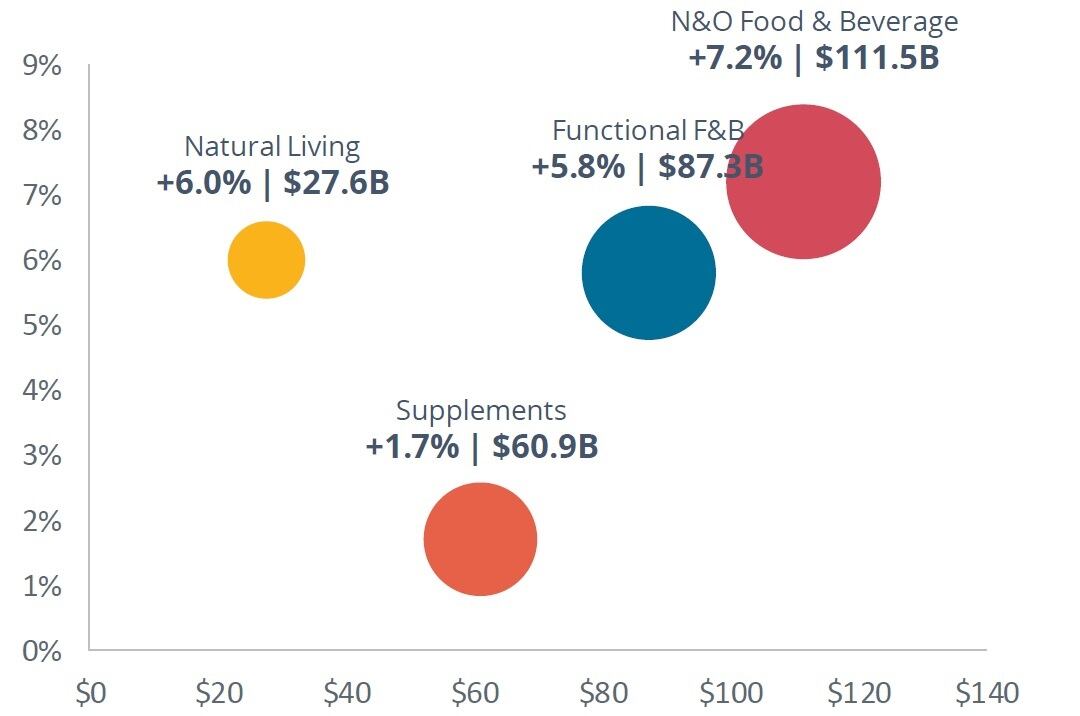“The total natural and organic products industry grew 5.4% to reach $278b in US consumer sales, according to early estimates from New Hopes’ Nutrition Business Journal,” Carlotta Mast, senior vice president and market leader at New Hope Network, told a packed room during the opening keynote at Expo West.
This is down from more than 7% growth in 2021 and a spike of nearly 10% growth in 2020, according to the data, which is powered by SPINS. Growth will likely continue to slow in 2023, with a predicted increase of about 5% before climbing closer to 6% in 2024 and 2025, she noted.
“The good news is that while growth did slow from 2020, when we experienced record sales expansion due to all the unprecedented pantry loading and other dynamics of the pandemic, the industry continued to grow last year despite … impacts of inflation,” Mast noted optimistically.
The bulk of this growth was driven by natural and organic food, which increased 7.5% to $111.5b, followed by a 6% increase to $27.6b in “natural living” products, which includes personal care, household items and pet products, and a 5.8% increase to $87.3b in functional food and beverage sales.
The supplement industry was hit the hardest in 2022, rising only 1.7% to $60.9b in sales, according to the data.
Despite the slowdown in sales across categories, the total industry is expected to surpass the $300b benchmark this year, which “would represent a doubling of industry sales over the last decade,” Mast said to applause. “That is a sizeable impact and shows we are a meaningful industry. We’re not a fad anymore. We’re not this niche industry anymore.”
The idea of natural and organic going mainstream is further reinforced by the sales growth across channels, with the increase of sales of natural products in regional grocery, conventional multioutlet and convenience all out pacing those in the natural channel. Growth of natural product sales in convenience led the way with a 9.2% increase, followed by a 7.4% increase in conventional multioutlet and a 4.1% increase in regional grocery channel compared to 2.5% in the natural channel, noted Kathryn Peters, chief of staff at SPINS.
What is driving growth in natural, organic and functional foods and beverages?
The bulk of the industry’s growth in 2022 came from natural, organic and functional food and beverage sales, which increased a combined 6.6% to $199b, Mast said.
“Some of the categories that did quite well were carbonated drinks – all of those gut healthy products that are hitting the market and other carbonated drinks. Those are bubbling up to the top of the best food and beverage categories in terms of sales, followed by dairy alternatives last year, better for us sweeteners, baby products and canned and dry soups,” Mast said.
Sales growth of organic food and beverage also began to bounce back in 2022, after taking a sizeable hit in 2021, when Nutrition Business Journal data estimates it fell to less than 2% after touching 13% in 2020. In 2022, sales growth edged back up slightly to about 4.6% and surpassed the $50b mark.
“This represents a doubling of organic food and beverage sales since 2014,” noted Mast.
She said the top growth categories in this segment were baby formula, candy, dips, soft drinks and yogurt.
Within functional food and beverage, the growth of which outperformed the total industry last year with a 5.8% increase that is expected to hold steady in 2023, the top drivers were sports and energy drinks, soft drinks, frozen desserts and snack chips, Mast said.
A closer inspection revealed the top functional ingredients driving growth in 2022 were electrolytes, mushrooms, adaptogens, healthy fats and prebiotics.

